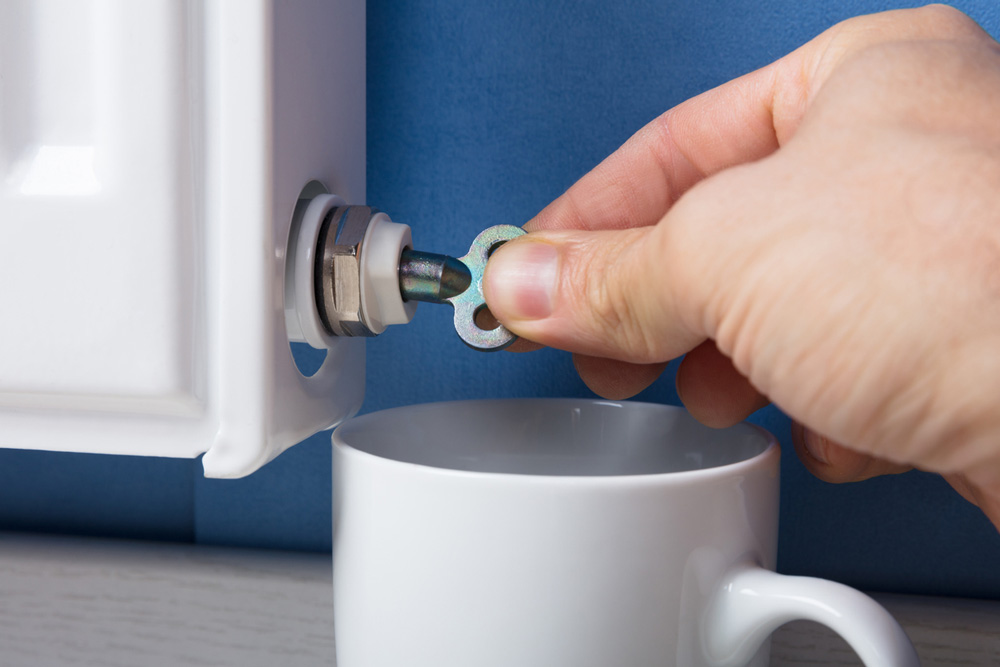How To Bleed A Radiator – Fixing Radiators That Are Cold At The Top
If you’re constantly experiencing rads being cold at the top — maybe when the cold season starts, and you haven’t used your system in a long while — it could mean you just need to bleed your radiators. Our quick-fire guide today will be covering how to bleed a radiator and will be giving detailed step by step instructions so that everyone could do it.

How To Bleed A Radiator
Ready to get started? Here’s the sequence you need to follow in order to bleed your radiators. Rest assured this is not rocket science. Just make sure you have a bleed key as mentioned below.
What You’ll Need
- Radiator bleed key (found in any DIY/hardware store, or on Amazon)
- A container to catch water
- Towels, or anything to protect walls and floors from water damage
How do you bleed a radiator (Step-By-Step Guide)
- Turn off your central heating, allowing all radiators and towel rails to cool down.
- Locate the radiator bleed screw.
- Assume water may dribble down the radiator and drip onto carpets; protect these areas.
- Assume water may squirt slightly when the valve is opened; protect these areas.
- Grab the radiator bleed key, and small container to catch water.
- Hold the container just under the bleed screw to catch any dribbles of water. A slight angle, will also allow you to catch any water that squirts out if you open the radiator bleed valve too quickly.
- Opening the valve slowly, expect to hear a hissing noise; this is air escaping from your radiator.
- As the hissing quietens, that’s a sign that the last bits of air are being released; get ready to close the bleed valve.
- Once hissing stops, it will be replaced with water leaking from the bleed valve. Close the valve.
How Do I Bleed A Radiator (VIDEO)
Bleeding Radiators: FAQ
Now that you know how to bleed a radiator, there are other questions that are highly important. For example how do you know when to bleed a radiator? The answer depends on your system, and maybe the time of the year. Here are a few questions you might have and answers to make sure everything goes smooth.
When To Bleed A Radiator?
When your central heating is not working for long periods of time, air can get into the system. That means you should be bleeding radiators whenever you restart your central heating for the cold season to make sure you’re free of airlocks. Another way to self-diagnose the need to bleed your radiators is you’re getting constantly cold-at-the-top radiators — this could also be a sign of airlocks in the system, so the first thing you should attempt is to bleed radiators.
Do I Need To Turn Off My Central Heating To Bleed Radiators?
Yes, it’s advisable to turn off your heating, allowing the whole system to cool down, before bleeding radiators.
How Does Bleeding A Radiator Help My Central Heating System?
Airlocks in radiators (or any part of your central heating system for that matter), decrease the efficiency of water flow; it acts in a similar way to a blockage. Bleeding radiators will remove airlocks, allowing your system to circulate water more efficiency.
If A Radiator Needs Bleeding, How Will I Know?
Radiators that are hot at the bottom, but cold at the top, are likely to have trapped air inside. Bleeding your radiators is going to remove the airlock, and allow the tops of your radiators to warm up.
My Boiler Pressure Has Dropped After Bleeding Radiators, What Should I Do?
If you’ve bled your radiators and now have a lack of boiler pressure, you’ll need to top it up using the filling loop.
Most boilers work best at 1.3 bar, but always refer to your owner’s manual to ensure this is the case.
How to Bleed a Radiator Without a Key?

Most modern radiators have a slot for a screwdriver. However, some older models have hex bolts that prevent you from using sockets.
Although you could probably use a pair of pliers, it’s not exactly wise. If you were to round it off with the valve still open, you’re going to have a lot of water to mop up.
What’s Next?
Thanks for reading our step-by-guide on bleeding radiators.
We regularly post up helpful guides and reviews relating to boilers and heating.
Like what you’ve read? Bookmark this page and pop back soon; you can use the search bar if you have any questions or drop us a line via our contact page.